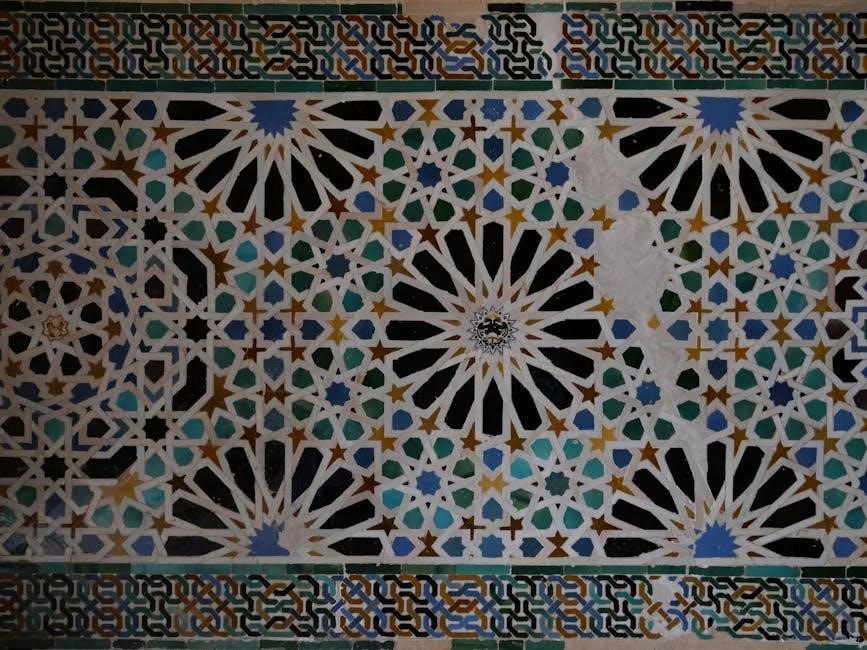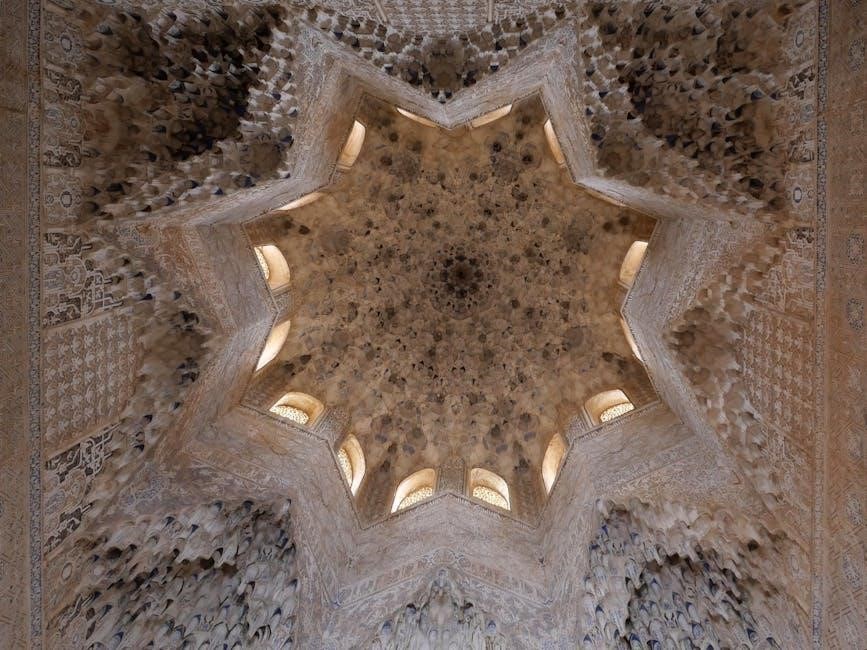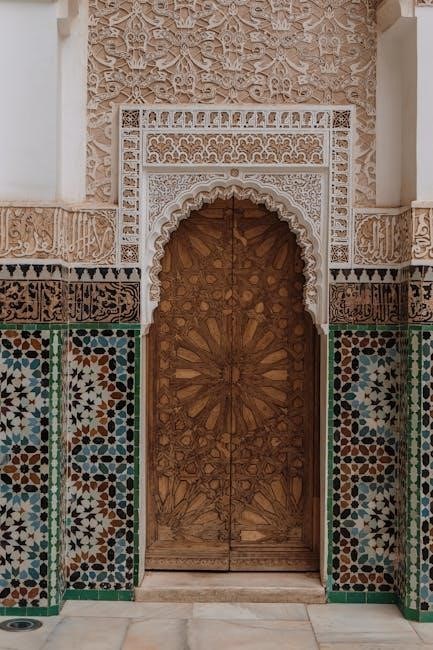Samuel Hazo’s Arabesque is a captivating poetic exploration of identity, blending personal and cultural narratives. This work delves into the interplay between tradition and modernity, offering a lyrical journey through heritage and self-discovery.

1.1 Overview of the Work
Arabesque by Samuel Hazo is a poetic collection that intricately weaves together themes of identity, culture, and personal history. The work explores the duality of Hazo’s Lebanese-American heritage, offering a deeply personal yet universally relatable narrative. Through a series of poems, Hazo delves into the complexities of belonging, memory, and the immigrant experience. His use of vivid imagery and lyrical language creates a rich tapestry of emotions, bridging the gap between tradition and modernity. The collection is structured to reflect the fluidity of cultural identity, with each poem serving as a fragment of a larger story. Hazo’s unique voice resonates throughout, blending the musicality of language with the depth of human experience. Arabesque is not only a reflection on Hazo’s own journey but also a broader exploration of what it means to navigate multiple worlds. Its poetic elegance and emotional resonance make it a compelling read for anyone interested in the intersections of culture and identity.
1.2 Historical and Cultural Significance
Samuel Hazo’s Arabesque holds profound historical and cultural significance, particularly in its exploration of identity and duality within Arab-American experiences. Written during a period of heightened cultural awareness, the poem reflects the tensions and harmonies between Eastern and Western traditions. Hazo’s work bridges cultural gaps, offering a unique lens through which to view the Arab diaspora’s struggle for self-definition. The poem’s rich imagery and lyrical prose resonate deeply, capturing the essence of a community navigating modernity while clinging to ancestral roots. Its historical context is marked by the immigrant experience, where preserving heritage becomes both a challenge and a source of strength. Arabesque not only mirrors the personal journey of its author but also embodies the universal quest for belonging. Its cultural impact lies in its ability to articulate the complexities of hybrid identity, making it a seminal work in contemporary literature.
The Life and Works of Samuel Hazo
Samuel Hazo, a celebrated poet and essayist, explores themes of identity and cultural duality in his works. His writing often reflects a deep connection to his heritage, blending personal narratives with universal themes.
2.1 Biography of Samuel Hazo
Samuel Hazo was born on July 19, 1928, in Pittsburgh, Pennsylvania, to a family of Lebanese descent. His early life was marked by a strong connection to his heritage, which later influenced his writing. Hazo earned his undergraduate degree from the University of Notre Dame and later received his Ph.D. in English from the University of Pittsburgh. He served in the U.S. Army during the Korean War, an experience that shaped his perspective on identity and culture. Hazo became a prominent figure in American literature, known for his poetic depth and exploration of cultural duality. He taught at several universities, including Duquesne University, where he was a professor emeritus. Hazo was also the founder of the International Poetry Forum and served as Pennsylvania’s first State Poet from 1993 to 2003. His work often reflects his Lebanese-American background, blending personal and cultural narratives.
2.2 His Contribution to Literature
Samuel Hazo’s literary contributions are marked by his unique voice and profound exploration of cultural duality. Through works like Arabesque, he bridges Eastern and Western traditions, offering a rich tapestry of identity and heritage. His poetry is celebrated for its lyrical depth, emotional resonance, and nuanced exploration of human experience. Hazo’s ability to weave personal narratives with broader cultural themes has made him a significant figure in contemporary literature. His work often challenges readers to reflect on their own identities and the interconnectedness of cultures. Hazo has also been recognized for his advocacy of poetry as a vital art form, emphasizing its power to transcend boundaries. His contributions have left a lasting impact on both Arab-American literature and the global literary community, inspiring future writers to explore similar themes of duality and cultural fusion.

Themes in “Arabesque”
Samuel Hazo’s Arabesque intricately explores themes of identity, cultural duality, and the interplay between tradition and modernity, weaving personal and collective experiences into a rich tapestry of poetic expression and introspection.
3.1 The Concept of Identity
In Arabesque, Samuel Hazo delves deeply into the concept of identity, weaving a narrative that explores the complexities of selfhood. Through poetic imagery and personal reflection, Hazo examines how identity is shaped by cultural heritage, personal history, and the interplay of tradition and modernity. The poems often grapple with the tension between belonging and displacement, reflecting Hazo’s own experiences as a bridge between Arab and American cultures. Identity is portrayed as a fluid and multifaceted construct, influenced by memory, language, and the search for belonging. Hazo’s exploration of identity is both intimate and universal, inviting readers to reflect on their own journeys of self-discovery. By blending the personal with the cultural, Arabesque offers a profound meditation on what it means to navigate the complexities of identity in a diverse and ever-changing world.
3.2 Exploring Cultural Duality
In Arabesque, Samuel Hazo masterfully explores the concept of cultural duality, reflecting his own experiences as an Arab-American poet. The collection delves into the tension and harmony between Arab heritage and Western influences, creating a rich tapestry of identity. Hazo’s poems often juxtapose the vibrant imagery of Arab culture—such as markets, deserts, and calligraphy—with the modern, urban landscapes of America. This duality is not merely a clash but a synthesis, where traditions and modernity coexist in a dance of contrasts. Through his lyrical language, Hazo captures the emotional and psychological nuances of navigating two worlds, revealing both the struggles and the beauty of this cultural interplay. His work invites readers to reflect on the universal human experience of belonging to multiple identities, making Arabesque a poignant exploration of cultural hybridity and its profound implications.

3.3 The Interplay of Tradition and Modernity

In Arabesque, Samuel Hazo masterfully explores the tension and harmony between tradition and modernity, reflecting his own cultural duality. The poems often juxtapose timeless themes, such as family, heritage, and spirituality, with contemporary existential questions. Hazo’s use of traditional Arabic motifs and storytelling techniques is intertwined with modern poetic forms, creating a unique blend that bridges past and present. This interplay is evident in his imagery, where ancient symbols like the desert, the mosque, and the call to prayer coexist with urban landscapes and modern introspection. Hazo’s work challenges the notion of a binary opposition between tradition and modernity, instead presenting them as complementary forces that enrich each other. Through this dynamic interplay, he crafts a narrative that is both deeply personal and universally relatable, offering readers a fresh perspective on identity and cultural evolution.
Poetic Style and Structure
Samuel Hazo’s poetic style in Arabesque features vivid imagery and intricate metaphors. The structure balances rhythm with free verse, creating a lyrical and expressive flow that mirrors the dance between identity and cultural duality.
4.1 Use of Language and Imagery
Samuel Hazo’s Arabesque is distinguished by its rich, evocative language and vivid imagery, which paint intricate scenes of cultural and personal reflection. Hazo employs a lyrical yet precise style, blending Arabic and English influences to create a unique poetic voice. His imagery often evokes the sensory details of Middle Eastern landscapes, traditions, and memories, immersing readers in a world of vibrant colors, sounds, and textures. The language is both intimate and expansive, capturing the nuances of identity and heritage. Hazo’s use of metaphor and simile adds depth, transforming everyday moments into profound meditations on belonging and displacement. The interplay of light and shadow in his descriptions mirrors the duality of his cultural experience, while his rhythmic phrasing enhances the emotional resonance of each poem; Through this masterful use of language, Hazo crafts a tapestry of stories that resonate universally, bridging the gap between personal and collective narratives.

4.2 Rhythm and Meter in the Poems
Samuel Hazo’s Arabesque showcases a masterful use of rhythm and meter, creating a musical quality that enhances the emotional depth of the poems. Hazo often employs free verse, allowing the natural cadence of language to guide the reader through his reflections. However, he also incorporates traditional poetic structures, such as iambic pentameter, to evoke a sense of timelessness and universality. The interplay between structured and fluid rhythms mirrors the cultural duality explored in the work, blending Arabic and Western influences seamlessly. Hazo’s use of enjambment and caesura adds complexity, allowing themes of identity and tradition to unfold dynamically. The deliberate pacing of his lines draws the reader into the intimate and often nostalgic narratives, making the poems both accessible and deeply resonant. Through his innovative approach to rhythm and meter, Hazo crafts a unique sonic experience that complements the rich imagery and symbolism in Arabesque.
4.3 Symbolism and Metaphor
In Arabesque, Samuel Hazo masterfully employs symbolism and metaphor to convey the complexities of identity and cultural duality. Symbols such as the arabesque motif itself represent the intricate, interconnected patterns of heritage and personal narrative. Hazo uses metaphors to bridge the gap between the tangible and the abstract, often drawing on natural imagery to illustrate emotional and cultural landscapes. For instance, the desert and the sea serve as metaphors for vast, uncharted territories of memory and identity. These literary devices not only enrich the poetic language but also deepen the reader’s understanding of the protagonist’s journey. Hazo’s use of symbolism and metaphor creates a layered, evocative narrative that invites reflection on the interplay between tradition and modernity. Through these techniques, he crafts a work that is both deeply personal and universally resonant, offering readers a profound exploration of self and culture.
Cultural and Historical Context
Samuel Hazo’s Arabesque draws from the rich tapestry of Middle Eastern culture and history, incorporating the timeless Arabesque motif. This poetic work reflects the Islamic Golden Age’s artistic and intellectual legacy, blending tradition with contemporary expression.
5.1 The Arabesque Motif in Art and Literature
The Arabesque motif, a cornerstone of Islamic art, is characterized by intricate, flowing patterns that symbolize the infinite and the divine. In literature, it often represents the interplay between form and fluidity, reflecting the harmony of opposites. Samuel Hazo’s Arabesque draws inspiration from this aesthetic, using it to explore themes of identity and cultural duality. The motif’s repetitive yet evolving nature mirrors the poet’s journey through personal and collective memory. By incorporating the Arabesque, Hazo bridges the gap between tradition and modernity, creating a poetic landscape that resonates with both historical and contemporary sensibilities. This motif not only enriches the work’s visual and symbolic depth but also underscores the universal language of art and culture. Hazo’s use of the Arabesque thus becomes a metaphor for the enduring beauty of cultural fusion and the timeless essence of artistic expression.
5.2 Historical Influences on the Work
Samuel Hazo’s Arabesque is deeply influenced by the rich cultural and historical tapestry of the Arab world. Drawing from centuries of Islamic art, literature, and philosophy, Hazo weaves together themes of identity, spirituality, and the interplay between East and West. The work reflects the historical migration of ideas and aesthetics, from the intricate patterns of Arabesque art to the poetic traditions of Al-Andalus. Hazo also nods to the legacy of Arab poets and thinkers, whose works have shaped the literary landscape. By incorporating these elements, Hazo bridges the past and present, creating a poetic dialogue that honors heritage while exploring contemporary relevance. The historical context of Arab cultural expression is central to the work, offering readers a glimpse into the enduring beauty and complexity of Arab identity.
5;3 The Role of Memory and Nostalgia
In Arabesque, Samuel Hazo intricately weaves memory and nostalgia as central themes, crafting a poetic tapestry that bridges past and present. Memory serves as both a narrative device and an emotional anchor, allowing Hazo to explore personal and collective experiences. Through vivid imagery and evocative language, he revisits moments of cultural and familial significance, blending them with contemporary reflections. Nostalgia, in particular, emerges as a poignant force, often tinged with a bittersweet longing for lost times and places. Hazo’s use of nostalgia is not merely sentimental but serves to illuminate the complexities of identity and belonging. By interlacing memory with nostalgia, he creates a lyrical dialogue between heritage and modernity, inviting readers to reflect on their own connections to the past. This interplay enriches the work’s emotional depth, making Arabesque a powerful exploration of how memory shapes our understanding of self and culture.

Reception and Impact
Samuel Hazo’s Arabesque received widespread acclaim for its lyrical depth and exploration of identity. Its cultural resonance and lasting influence have made it a cherished work, appreciated by both scholars and general readers.

6.1 Initial Reception of “Arabesque”
Upon its release, Arabesque garnered significant attention for its unique blend of cultural introspection and poetic elegance. Critics praised Hazo’s ability to weave personal narratives with broader cultural themes, creating a work that resonated deeply with readers. The collection was celebrated for its emotional depth and its exploration of identity, particularly within the Arab-American experience. Many reviewers highlighted Hazo’s masterful use of language, which brought a fresh perspective to themes of heritage and belonging. The book quickly became a subject of discussion in literary circles, with many hailing it as a landmark work in contemporary poetry. Its initial success also drew attention to Hazo’s growing influence as a voice for cross-cultural understanding. Overall, Arabesque was warmly received, setting the stage for its enduring legacy in literary circles.
6.2 Critical Analysis and Reviews
Critical analysis of Arabesque highlights its profound exploration of cultural duality and identity. Reviewers praise Hazo’s lyrical prose and rich imagery, which weave together personal and collective memories. The work is celebrated for its nuanced portrayal of the Arab-American experience, blending tradition with modernity. Critics note how Hazo’s use of metaphor and symbolism creates a layered narrative, inviting readers to reflect on their own identities. Some reviewers emphasize the emotional depth of the poems, which resonate universally despite their specific cultural context. However, a few critics argue that the interplay between past and present occasionally feels disjointed. Overall, Arabesque is lauded as a significant contribution to contemporary poetry, offering a compelling exploration of heritage and belonging. Its ability to balance the personal and the universal has solidified its place in literary discourse.
6.3 The Work’s Lasting Legacy
Samuel Hazo’s Arabesque has left an indelible mark on contemporary poetry, celebrated for its nuanced exploration of identity and cultural duality. Its lyrical prose and profound themes continue to resonate with readers, inspiring new generations of writers. The work’s ability to bridge cultural divides has solidified its place in literary canon, making it a cornerstone of poetic discourse. Hazo’s unique voice and masterful storytelling have influenced countless poets, shaping the trajectory of modern poetry. Arabesque remains a testament to Hazo’s genius, ensuring his legacy endures as a pivotal figure in 20th-century literature. Its timeless appeal lies in its universal themes, transcending time and culture, offering readers a mirror to reflect on their own identities and heritage. As a result, Arabesque is not only a defining work of Hazo’s career but also a cherished gem in the world of poetry.

Comparative Analysis
Samuel Hazo’s Arabesque shares thematic elements with his earlier works, such as explorations of identity and cultural duality, yet its unique lyrical depth and nuanced imagery set it apart in his literary canon.
7.1 Comparison with Other Works by Hazo

Samuel Hazo’s Arabesque reflects a continuity of themes found in his earlier works, such as the exploration of identity and cultural duality. However, its unique focus on the interplay between tradition and modernity distinguishes it from his other poetry collections. While works like Stills and Once emphasize personal and familial narratives, Arabesque expands this scope to encompass a broader cultural landscape. The use of imagery and symbolism in Arabesque is more intricate, mirroring the arabesque motif’s fluid, interconnected patterns. Hazo’s signature lyrical style remains consistent, but the depth of historical and cultural context in Arabesque sets it apart. This work can be seen as a culmination of his lifelong exploration of identity, blending the personal with the universal in a way that resonates deeply with readers familiar with his oeuvre.

